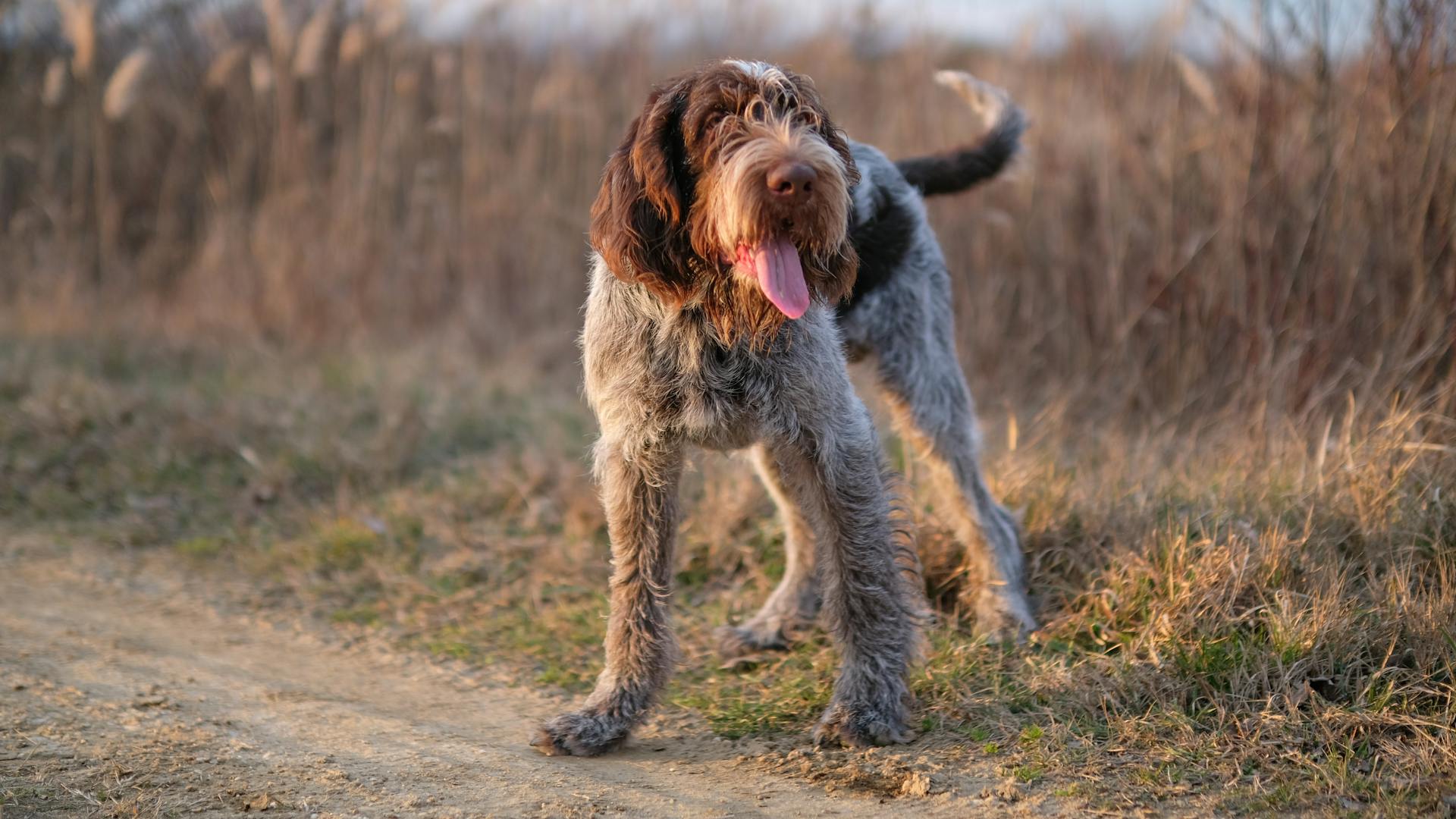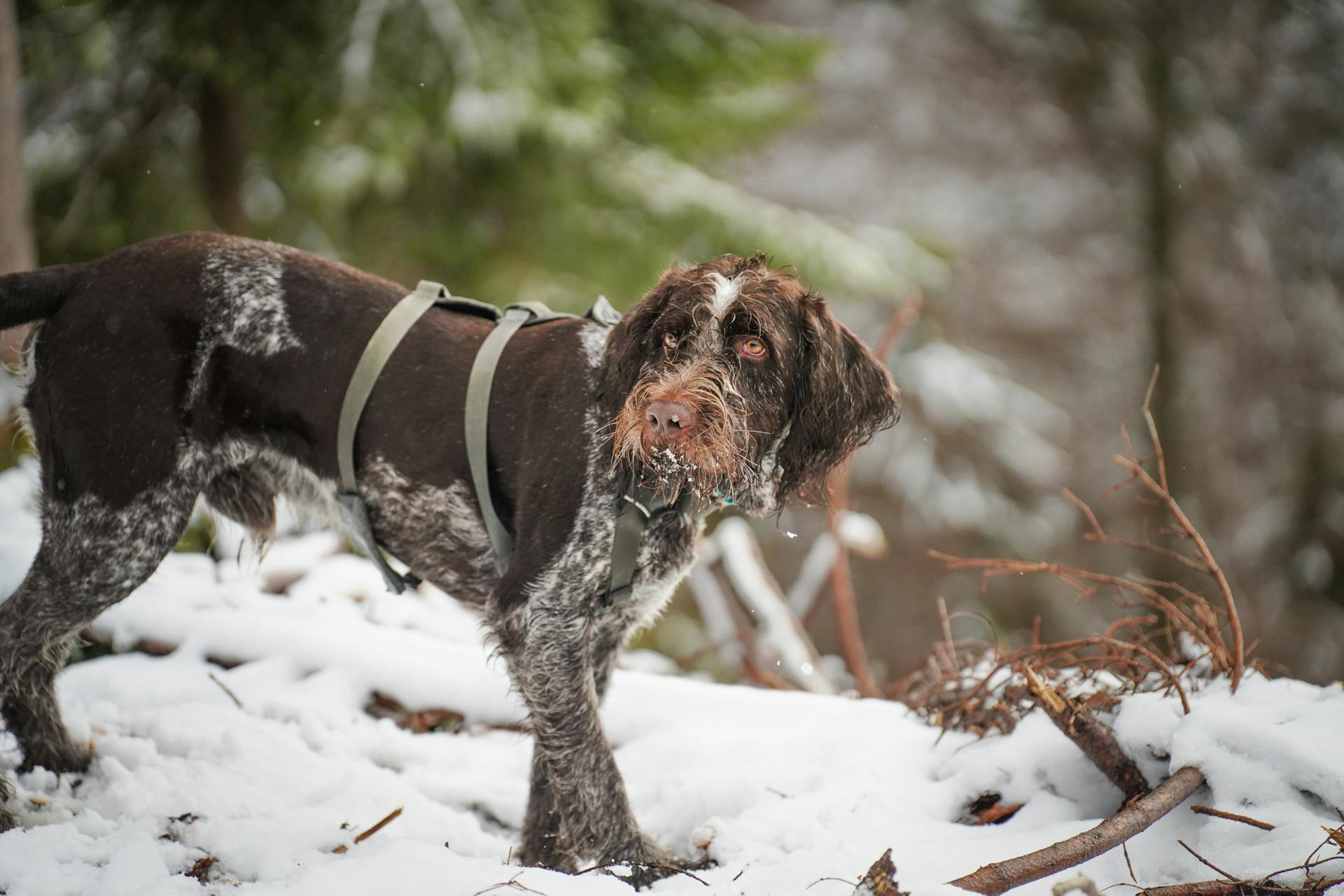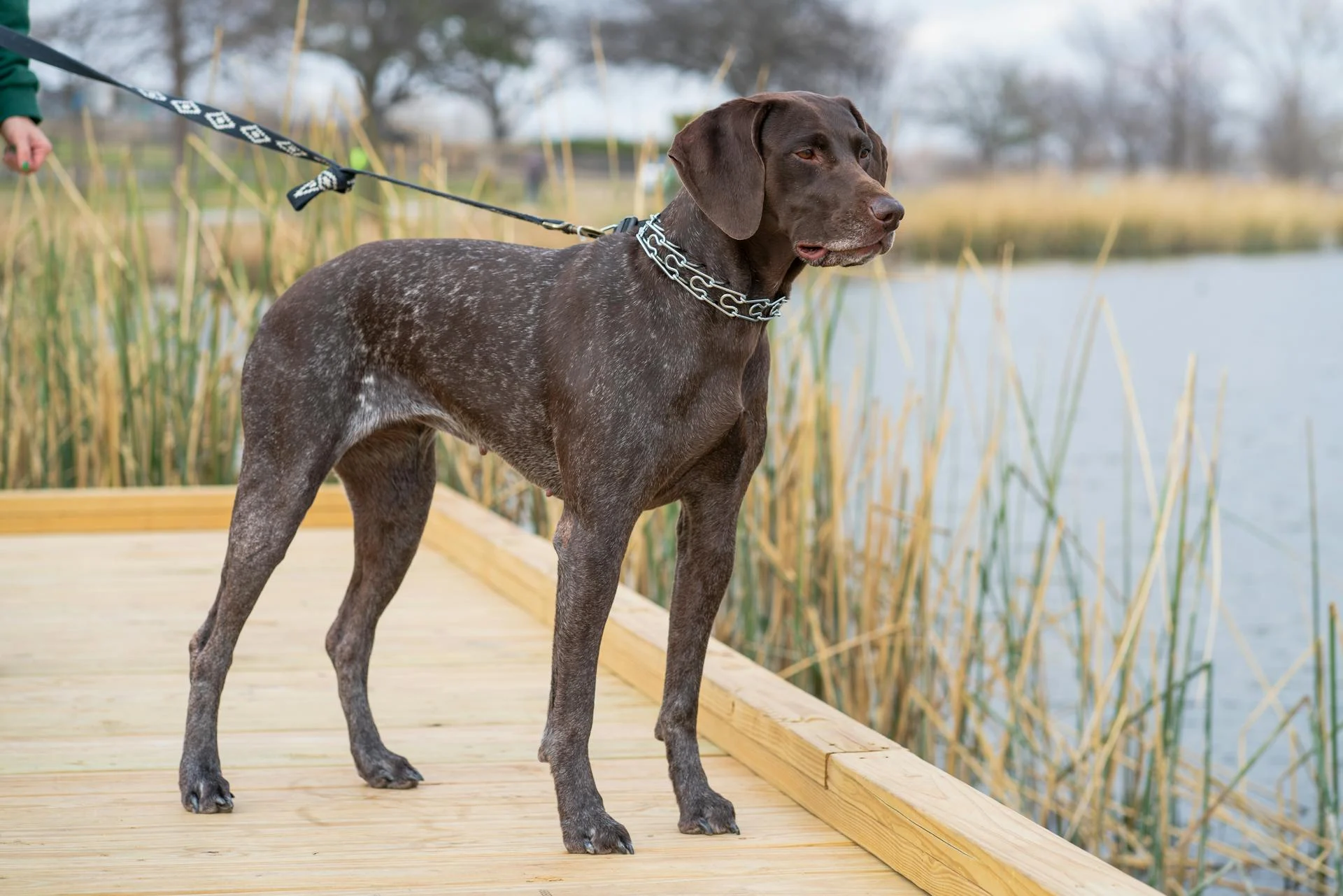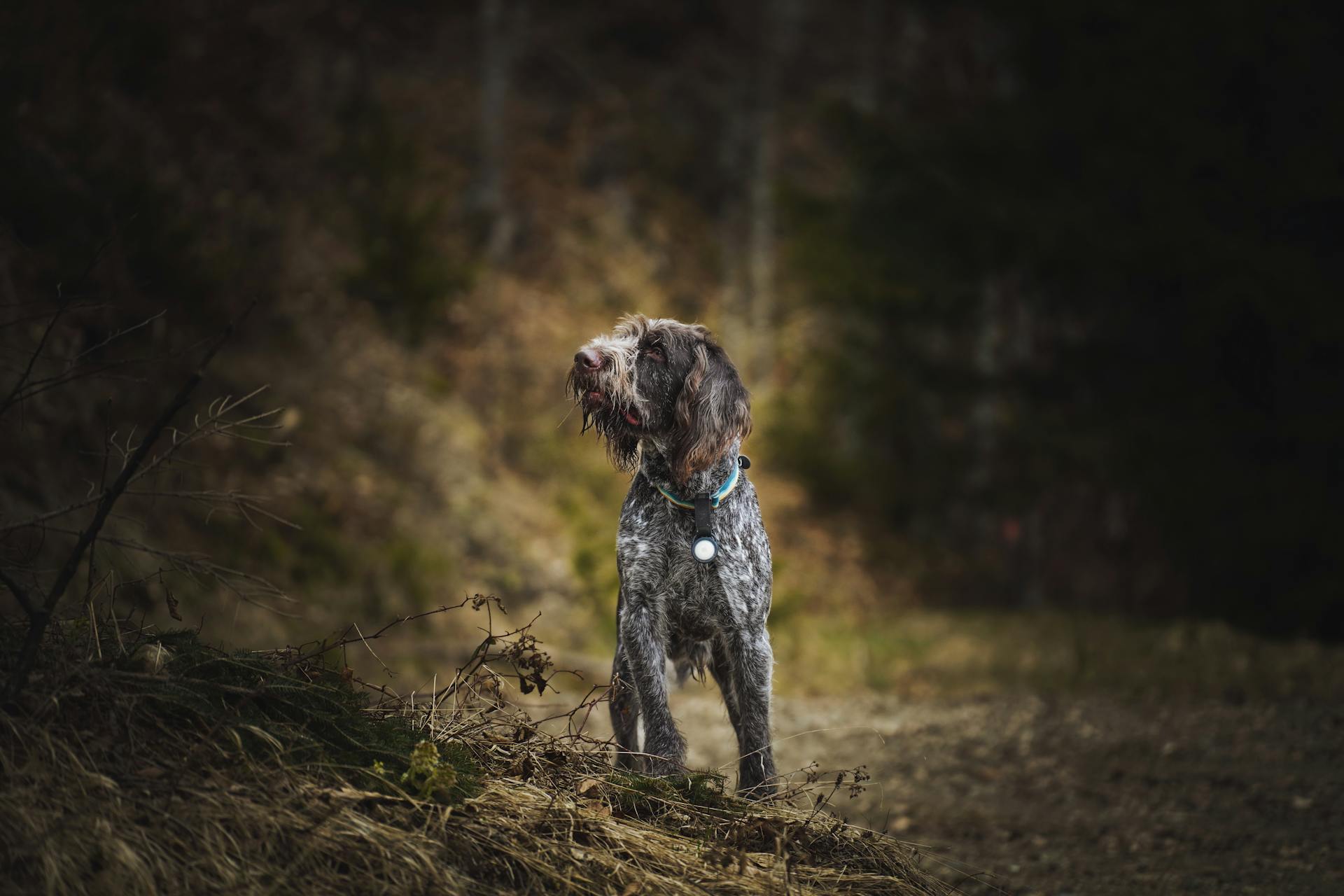
The German Wirehaired Pointer is a breed known for its distinctive coat, which is a key part of its charm. They shed heavily twice a year, with the shedding season typically lasting about 2-3 weeks.
Their thick undercoat is responsible for the majority of their shedding, and it's essential to brush them regularly to prevent matting and tangling. Brushing also helps to distribute skin oils and keep their coat healthy.
Grooming is a crucial aspect of German Wirehaired Pointer care, and it's recommended to brush them at least 2-3 times a week, with daily brushing during shedding season. Regular nail trimming and ear cleaning are also essential to prevent health issues.
Maintenance and Grooming
Maintenance and Grooming is crucial for German Wirehaired Pointers. Regular ear cleaning and nail trimming should be completed every 1 to 2 weeks; nails may not grow as often so every 2 to 3 weeks may be sufficient.
To keep their coat healthy and wiry, German Wirehaired Pointers need to be stripped or plucked twice a year. This can be a time-consuming task, but it's essential for maintaining their unique double coat.
You'll also want to brush out any dirt, debris, or mud after they've dried, and bathe them only when necessary – usually twice a year, or after stripping. Use a shampoo specifically made for wirehaired dogs to keep their coat in top condition.
Here's a quick rundown of regular grooming tasks:
- Clean their ears regularly to prevent infections
- Clip or grind their nails to prevent overgrowth
- Check between their pads for foreign objects
- Bathe them only when necessary, using a shampoo made for wirehaired breeds
Grooming Your
Grooming your German Wirehaired Pointer requires attention to their unique coat and needs.
Their coat is easy to care for, but it does have a few special needs to maintain a healthy, wiry double coat. You'll need to strip or pluck their coat twice a year, which can be a time-consuming task.
Brushing their beard and mustache daily is crucial to remove food particles and prevent odors. Use a steel comb specifically designed for wirehaired dogs.
Regular ear cleaning is essential, and you should check for brown debris, redness, or foul smells. If you notice your dog shaking their head or scratching their ears, it may be a sign of an infection.
Nail trimming should be done every 1 to 2 weeks, as their nails may not grow as often. Use a dremel grinder or clippers, but be careful not to grind too short or keep the grinder on the nail for too long.
Here's a quick rundown of grooming tasks to keep in mind:
- Clean their ears with cotton swabs and check for signs of infection.
- Trim their nails using a dremel grinder or clippers.
- Check between their pads for foreign objects.
- Bathe them as needed, using a shampoo made for wire-coated breeds.
Bathtime is rare for German Wirehaired Pointers, as their coats tend to shed dirt easily. But when they do get dirty, a good brushing and a bath with the right shampoo can work wonders.
Similar Maintenance Breeds
If you're considering a German Wirehaired Pointer as your next furry friend, you may be wondering about the grooming needs of this breed. The good news is that there are some similar maintenance breeds that require similar care.
See what others are reading: Dogs Similar to Border Collies
These breeds are known for their high energy levels and thick coats, which need regular brushing and maintenance to prevent matting and tangling. A good example is the Slovakian Rough-haired Pointer, which has a 94% similarity to the German Wirehaired Pointer in terms of maintenance needs.
Some of these breeds are also known for their intelligence and trainability, making them great companions for active owners. The Doxie Scot, for instance, has a 94% similarity to the German Wirehaired Pointer in terms of maintenance needs.
Here are some similar maintenance breeds to consider:
- Havana Silk (94% similar)
- Doxie Scot (94% similar)
- Shar-Pei Pitbull Terrier (94% similar)
- Slovakian Rough-haired Pointer (94% similar)
- Pointer Bay (94% similar)
Similar Breeds
If you're considering bringing a German wirehaired pointer into your family, you may also want to look into other breeds that share similar qualities.
The German shorthaired pointer is a close relative of the German wirehaired pointer, with similar hunting instincts and energy levels.
If you're looking for a breed with a thick coat like the German wirehaired pointer, the Stichelhaar and Drahthaars breeds are worth considering.
These breeds all have thick coats that require regular grooming to prevent matting and tangling, just like the German wirehaired pointer.
Here are some similar breeds to the German wirehaired pointer that you may want to learn more about:
- German shorthaired pointer
- Stichelhaar
- Drahthaars
Similarly Sized Breeds
If you're looking for breeds that are similar in size to the German Wirehaired Pointer, you're in luck. There are several breeds that share similar characteristics.
The Slovakian Rough-haired Pointer is one of the closest matches, with a similarity of 99%. This breed is known for its rugged appearance and high energy level.
Another breed that's worth considering is the Deutsch Drahthaar, which is also 99% similar to the German Wirehaired Pointer. This breed is a versatile hunting companion that excels in a variety of terrain.
If you're looking for a breed that's slightly smaller, the Black and Tan Coonhound is a great option at 98% similar. This breed is known for its distinctive baying howl and strong prey drive.
If you're open to a breed that's a bit more unique, the Doberman Collie is worth considering at 97% similar. This breed is a cross between a Doberman Pinscher and a Rough Collie, making it a fascinating mix of characteristics.
Finally, the German Longhaired Pointer is another breed that's 97% similar, making it a great option if you're looking for a breed with a similar coat type and hunting style.
Here's a quick rundown of these breeds:
Related Breeds
If you're looking for breeds similar to the German Wirehaired Pointer, you'll find that some share up to 94% similarity in their characteristics.
The Havana Silk, for instance, has a 94% similarity with the German Wirehaired Pointer.
Other breeds that share this high level of similarity include the Doxie Scot, Shar-Pei Pitbull Terrier, Slovakian Rough-haired Pointer, and Pointer Bay.
You may also want to consider the German Shorthaired Pointer, which is a related breed to the German Wirehaired Pointer.
Here are some breeds that are similar or related to the German Wirehaired Pointer:
- Havana Silk (94% similar)
- Doxie Scot (94% similar)
- Shar-Pei Pitbull Terrier (94% similar)
- Slovakian Rough-haired Pointer (94% similar)
- Pointer Bay (94% similar)
- German Shorthaired Pointer (related breed)
Standard Information
The German Wirehaired Pointer is a medium to large-sized dog breed with a thick, double coat that sheds heavily.
They typically weigh between 45-65 pounds and stand between 21.5-24.5 inches tall at the shoulder.
Their coat is made up of a soft undercoat and a harsh outer coat that sheds heavily, especially during shedding season.
This breed sheds moderately to heavily year-round, but heavily during seasonal changes.
Grooming needs are high, with daily brushing required to prevent matting and tangling of the coat.
Care and Temperament
German wirehaired pointers crave human attention and will often follow you around like a second shadow.
They are fun-loving, full of energy, and always game for an adventure, making them a great companion for active families. This breed requires lots of time outside, so be prepared for long walks and regular trips to a nature trail.
Training is most effective when you give them a job to do, and positive reinforcement training with treats works well. German wirehaired pointers respond well to training and love making their owners happy.
Return
The German Wirehaired Pointer is a loving companion that returns your affection in full measure. With proper attention, training, and mental stimulation, your GWP will shower you with love.
Their high intelligence (high) makes them relatively easy to train, but their willful nature means you'll need to be consistent and patient. With positive reinforcement, they'll learn quickly and become a loyal companion.

This breed is built for outdoor adventures, with a medium size (26-60 lbs) and a short, wiry coat that sheds normally. They're tolerant of cold and hot weather, making them perfect for hiking companions.
Here are some key traits to consider when bringing a GWP into your family:
Overall, the German Wirehaired Pointer is a wonderful breed that will return your love and companionship in full measure, as long as you provide the attention and care they need.
Temperament
German wirehaired pointers are loyal companions that crave human attention and will often follow you around like a second shadow. They're fun-loving, full of energy, and always game for an adventure.
They're extremely active and require lots of time outside, so if you live in the 'burbs or city, take them out on long, daily walks to get a good workout. This is because they were bred to be hunting dogs and have a strong instinct to run around in nature for hours at a time.
Intriguing read: Are German Shepherds Good for First Time Owners
Training is most effective when you give them a job to do, and they respond well to positive reinforcement training with treats. You can spend 5-10 minutes a couple times a day teaching your GWP something, like obedience or fetch.
Their love for their people makes them fit into most families and get along well with children, but it's essential to supervise and ensure they don't accidentally knock down your toddler while trying to play.
Care
German wirehaired pointers are low maintenance when it comes to grooming. They shed lightly year-round and only need their coat brushed or combed weekly to remove dirt or debris.
Their weather-resistant coat means you can brush out mud and dirt once it dries, eliminating the need for frequent baths. You'll only need to bathe them a few times a year, unless they get into something stinky.
Make sure to pay special attention to the area around their mouth, as food tends to get stuck in their whiskers. Regular brushing is also a great opportunity to check their ears and clean them out if needed.
Intriguing read: How Much Exercise Do Labrador Retrievers Need

Trimming their nails regularly is essential to prevent discomfort while walking, running, or playing. If your dog has a longer-than-average coat, you might need to strip their coat two or three times a year to remove dead hair by the root.
Training is most effective when German wirehaired pointers are given a job to do. They thrive on structure and praise, and can become mischievous if left to their own devices.
History and Appearance
The German Wirehaired Pointer's history dates back to the late 1800s when German breeders developed a breed that could perform multiple tasks on various terrains. They combined characteristics of other pointing breeds, including the wirehaired pointing griffon, to create a versatile hunting dog.
This breed was developed to search and point at various kinds of game, retrieve birds, and hunt alongside their owners. They were also great companions.
One of the most distinctive characteristics of the German Wirehaired Pointer is its wiry coat, which is weather-resistant and somewhat water-repellent. The undercoat is dense and provides great insulation during cold months, while the outercoat is wiry, harsh to touch, and straight.
GWPs come in various colors, including liver, liver and white, liver roan, and black and white. They have a distinctive facial expression due to their shaggy eyebrows, mustache, and beard.
Curious to learn more? Check out: What Does a Lhasa Apso Look like
History

The German Wirehaired Pointer is a breed with a rich history that spans over a century. It originated in Germany in the late 1800s, where breeders wanted a dog that could perform many tasks on various kinds of terrains for an all-around ideal hunting dog.
Breeders combined characteristics of other pointing breeds, including the Wirehaired Pointing Griffon, to develop this do-it-all breed that could search and point at various kinds of game, retrieve birds, and hunt alongside their owners – all while being a great companion.
In 1870, the German Wirehaired Pointer was first bred to be a versatile and rugged hunting dog, capable of hunting on rough terrain. This breed was developed by making careful cross breedings with other breeds, including the German Pointer and the Pudelpointer.
The breed's name comes from the English translation of the German breed name, Deutsch-Drahthaar. The German Wirehaired Pointer was first imported to the United States in the 1920s, and it became an officially recognized breed by the American Kennel Club in 1959.
Today, the German Wirehaired Pointer remains one of the most popular dog breeds in Germany, where they're known as the Deutsch-Drahthaar.
Expand your knowledge: German Drahthaar Pointer
Appearance

The German Wirehaired Pointer's most distinctive feature is its wiry coat, which is weather-resistant and somewhat water-repellent.
Their coat is made up of a dense undercoat that provides great insulation during the cold months, but sheds out for the summer months. This makes them perfect for outdoor activities.
The wiry outercoat is harsh to the touch and straight, laying flat and typically one to two inches in length. Their eyebrows are made up of straight hair that's slightly longer than the hair on their skull.
Their beard is medium-length, and they can come in a variety of colors, including liver, liver and white, liver roan, and black. A white blaze on their head is also acceptable.
Adult German Wirehaired Pointers typically weigh between 50-70 pounds, with females reaching around 22 inches in height and males standing at 24-26 inches tall.
They have a stocky build and a distinctive facial expression, thanks to their shaggy eyebrows, mustache, and beard. This gives them a refined and intelligent look that's hard to miss.
Intriguing read: Bernese Mountain Dog 6 Months
Frequently Asked Questions
How often should I bathe my German Wirehaired Pointer?
Bathing your German Wirehaired Pointer is not a frequent task, with a recommended frequency of twice a year, unless they get dirty or smelly. Regular brushing can help keep them clean in between baths.
Sources
- https://www.akc.org/dog-breeds/german-wirehaired-pointer/
- https://wagwalking.com/breed/german-wirehaired-pointer
- https://www.dailypaws.com/dogs-puppies/dog-breeds/german-wirehaired-pointer
- https://blog.healthypawspetinsurance.com/german-wirehaired-pointer-breed-guide-pet-insurance
- http://germanwirehair.blogspot.com/2008/06/grooming-your-german-wirehair-pointer.html
Featured Images: pexels.com


